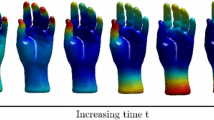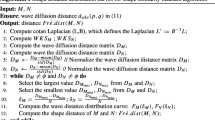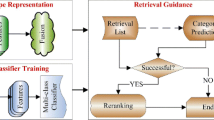Abstract
In the past decades, feature-learning-based 3D shape retrieval approaches have been received widespread attention in the computer graphic community. These approaches usually explored the hand-crafted distance metric or conventional distance metric learning methods to compute the similarity of the single feature. The single feature always contains onefold geometric information, which cannot characterize the 3D shapes well. Therefore, the multiple features should be used for the retrieval task to overcome the limitation of single feature and further improve the performance. However, most conventional distance metric learning methods fail to integrate the complementary information from multiple features to construct the distance metric. To address these issue, a novel multi-feature distance metric learning method for non-rigid 3D shape retrieval is presented in this study, which can make full use of the complimentary geometric information from multiple shape features by utilizing the KL-divergences. Minimizing KL-divergence between different metric of features and a common metric is a consistency constraints, which can lead the consistency shared latent feature space of the multiple features. We apply the proposed method to 3D model retrieval, and test our method on well known benchmark database. The results show that our method substantially outperforms the state-of-the-art non-rigid 3D shape retrieval methods.







Similar content being viewed by others
References
Aubry M, Schlickewei U, Cremers D (2011) The wave kernel signature: A quantum mechanical approach to shape analysis. In: 2011 IEEE international conference on computer vision workshops (ICCV Workshops), pp 1626–1633. IEEE
Bronstein AM, Bronstein MM, Guibas LJ, Ovsjanikov M (2011) Shape google: Geometric words and expressions for invariant shape retrieval. ACM Trans Graph (TOG) 30(1):1
Bronstein MM, Kokkinos I (2010) Scale-invariant heat kernel signatures for non-rigid shape recognition. In: 2010 IEEE conference on computer vision and pattern recognition (CVPR), pp 1704–1711. IEEE
Chiotellis I, Triebel R, Windheuser T, Cremers D (2016) Non-rigid 3d shape retrieval via large margin nearest neighbor embedding. In: European conference on computer vision, pp 327–342. Springer
Davis JV, Kulis B, Jain P, Sra Suvrit, Dhillon IS (2007) Information-theoretic metric learning. In: Proceedings of the 24th international conference on Machine learning, pp 209–216. ACM
Hardoon DR, Szedmak Sr, Shawe-Taylor J (2004) Canonical correlation analysis: An overview with application to learning methods. Neural Comput 16(12):2639–2664
Hu J, Lu J, Tan Y-P (2014) Discriminative deep metric learning for face verification in the wild. In: Proceedings of the IEEE conference on computer vision and pattern recognition, pp 1875–1882
Kan M, Shan S, Zhang H, Lao S, Chen X (2016) Multi-view discriminant analysis. IEEE Trans Pattern Anal Mach Intell 38(1):188–194
Kuang Z, Li Z, Lv Q, Weiwei T, Liu Y (2015) Modal function transformation for isometric 3d shape representation. Comput Graph 46:209–220
Kumar A, Rai P, Daume H (2011) Co-regularized multi-view spectral clustering. In: Advances in neural information processing systems, pp 1413–1421
Li C, Hamza BA (2013) Intrinsic spatial pyramid matching for deformable 3d shape retrieval. International Journal of Multimedia Information Retrieval 2(4):261–271
Li C, Hamza BA (2014) Spatially aggregating spectral descriptors for nonrigid 3d shape retrieval: a comparative survey. Multimed Syst 20(3):253–281
Lian Z (2015) Shrec’15 track: Non-rigid 3d shape retrieval
Lian Z, Godil A, Bustos B, Daoudi M, Hermans J, Kawamura S, Kurita Y, Lavoua G, Suetens PDP (2011) Shape retrieval on non-rigid 3d watertight meshes. In: Eurographics workshop on 3d object retrieval (3DOR)
Lian Z, Godil A, Bustos B, Daoudi M, Hermans J, Kawamura S, Kurita Y, Lavoué G, Van Nguyen H, Ohbuchi R et al (2013) A comparison of methods for non-rigid 3d shape retrieval. Pattern Recogn 46(1):449–461
Lian Z, Godil A, Fabry T, Furuya T, Hermans J, Ohbuchi R, Shu C, Smeets D, Suetens P, Vandermeulen D et al (2010) Shrec’10 track: Non-rigid 3d shape retrieval. 3DOR 10:101–108
Limberger FA (2017) Spectral signatures for non-rigid 3D shape retrieval. University of York, PhD thesis
Limberger FA, Wilson RC (2015) Feature encoding of spectral signatures for 3d non-rigid shape retrieval. In: BMVC, pp 56–1
Litman R, Bronstein A, Bronstein M, Castellani U (2014) Supervised learning of bag-of-features shape descriptors using sparse coding. In: Computer Graphics Forum, vol 33, pp 127–136. Wiley Online Library
Mika S, Ratsch Gr, Weston J, Scholkopf B, Mullers K-R (1999) Fisher discriminant analysis with kernels. In: Neural networks for signal processing IX, 1999. Proceedings of the 1999 IEEE signal processing society workshop., pages 41–48. IEEE
Ohbuchi R, Furuya T (2010) Distance metric learning and feature combination for shape-based 3d model retrieval. In: Proceedings of the ACM workshop on 3D object retrieval, pp 63–68. ACM
Pickup D, Sun X, Rosin PL, Martin RR, Cheng Z, Lian Z, Aono M, Hamza Ben A, Bronstein A, Bronstein M (2014) Shape retrieval of non-rigid 3d human models. In: Eurographics workshop on 3d object retrieval
Pinkall U, Polthier K (1993) Computing discrete minimal surfaces and their conjugates. Exp Math 2(1):15–36
Reuter M, Wolter F-E, Peinecke N (2006) Laplace–beltrami spectra as ’shape-dna’of surfaces and solids. Comput Aided Des 38(4):342–366
Rustamov RM (2007) Laplace-beltrami eigenfunctions for deformation invariant shape representation. In: Proceedings of the 5th Eurographics symposium on Geometry processing, pp 225–233. Eurographics Association
Shilane P, Min P, Kazhdan M, Funkhouser T (2004) The princeton shape benchmark. In: Proceedings shape modeling applications, 2004., pp 167–178. IEEE
Sun J, Ovsjanikov M, Guibas L (2009) A concise and provably informative multi-scale signature based on heat diffusion. In: Computer graphics forum, vol 28, pp 1383–1392. Wiley Online Library
Suykens JAK, Vandewalle J (1999) Least squares support vector machine classifiers. Neural Process Lett 9(3):293–300
Wang H, Feng L, Zhang J, Liu Y (2016) Semantic discriminative metric learning for image similarity measurement. IEEE Trans Multimed 18(8):1579–1589
Wang Y, Lin X, Wu L, Zhang W, Qing Zhang. (2014) Exploiting correlation consensus: Towards subspace clustering for multi-modal data. In: Proceedings of the 22nd ACM international conference on Multimedia, pp 981–984. ACM
Wang Y, Lin X, Wu L, Zhang W (2017) Effective multi-query expansions: Collaborative deep networks for robust landmark retrieval. IEEE Transactions on Image Processing
Wang Y, Lin X, Wu L, Zhang W, Zhang Q, Huang X (2015) Robust subspace clustering for multi-view data by exploiting correlation consensus. IEEE Trans Image Process. 24(11):3939–3949
Wang Y, Wu L (2018) Beyond low-rank representations: Orthogonal clustering basis reconstruction with optimized graph structure for multi-view spectral clustering. Neural Netw 103:1–8
Wang Y, Wu L, Lin X, Gao J (2018) Multiview spectral clustering via structured low-rank matrix factorization. IEEE Transactions on Neural Networks and Learning Systems
Wang Y, Zhang W, Wu L, Lin X, Fang M, Pan S (2016) Iterative views agreement: An iterative low-rank based structured optimization method to multi-view spectral clustering. In: International joint conference on artificial intelligence (IJCAI)
Wang Y, Zhang W, Wu L, Lin X, Zhao X (2017) Unsupervised metric fusion over multiview data by graph random walk-based cross-view diffusion. IEEE Trans Neural Netw Learning Syst 28(1):57–70
Wang Yang, Lin Xuemin, Lin W u, expansions Wenjie Zhang. (2015) Effective multi-query Robust landmark retrieval. In: Proceedings of the 23rd ACM international conference on Multimedia, pp 79–88. ACM
Weinberger KQ, Saul LK (2009) Distance metric learning for large margin nearest neighbor classification. J Mach Learn Res 10(Feb):207–244
Wold S, Esbensen K, Geladi P (1987) Principal component analysis. Chemom Intell Lab Syst 2(1-3):37–52
Wu L, Wang Y, Gao J, Li X (2018) Deep adaptive feature embedding with local sample distributions for person re-identification. Pattern Recogn 73:275–288
Wu L, Wang Y, Gao J, Li X (2018) Where-and-when to look: Deep siamese attention networks for video-based person re-identification. IEEE Transactions on Multimedia
Wu L, Wang Y, Li X, Gao J (2018) Deep attention-based spatially recursive networks for fine-grained visual recognition. IEEE Transactions on Cybernetics
Wu L, Wang Y, Li X, Junbin G (2018) What-and-where to match: Deep spatially multiplicative integration networks for person re-identification. Pattern Recogn 76:727–738
Wu L, Wang Y, Shao L (2019) Cycle-consistent deep generative hashing for cross-modal retrieval. IEEE Trans Image Process 28(4):1602–1612
Wu L, Wang Y, Shao L, Wang M (2018) 3d personvlad: Learning deep global representations for video-based person re-identification. arXiv:1812.10222
Wu P, Hoi SCH, Zhao P, Miao C, Liu Z-Y (2016) Online multi-modal distance metric learning with application to image retrieval. IEEE Trans Knowl Data Eng 28(2):454–467
Xie J, Dai G, Yi F (2017) Deep multimetric learning for shape-based 3d model retrieval. IEEE Trans Multimed 19(11):2463–2474
Xie J, Dai G, Zhu F, Wong EK, Fang Y (2017) Deepshape Deep-learned shape descriptor for 3d shape retrieval. IEEE Trans Pattern Anal Mach Intell 39 (7):1335–1345
Xu C, Tao D, Xu C (2013) A survey on multi-view learning. arXiv:1304.5634
Xu C, Tao D, Xu C (2015) Multi-view self-paced learning for clustering. In: IJCAI, pp 3974–3980
Zhai D, Chang H, Shan S, Chen X, Gao W (2012) Multiview metric learning with global consistency and local smoothness. ACM Transactions on Intelligent Systems and Technology (TIST) 3(3):53
Acknowledgments
This study was funded by the National Natural Science Foundation of China Grant 61370142 and Grant 61272368, by the Fundamental Research Funds for the Central Universities Grant 3132016352, by the Fundamental Research of Ministry of Transport of P.R. China Grant 2015329225300. Huibing Wang, Haohao Li and Xianping Fu declare that they have no conflict of interest. Huibing Wang and Haohao Li contribute equally to this article. This article does not contain any studies with human participants or animals performed by any of the authors.
Author information
Authors and Affiliations
Corresponding author
Additional information
Publisher’s note
Springer Nature remains neutral with regard to jurisdictional claims in published maps and institutional affiliations.
Rights and permissions
About this article
Cite this article
Wang, H., Li, H., Peng, J. et al. Multi-feature distance metric learning for non-rigid 3D shape retrieval. Multimed Tools Appl 78, 30943–30958 (2019). https://doi.org/10.1007/s11042-019-7670-9
Received:
Revised:
Accepted:
Published:
Issue Date:
DOI: https://doi.org/10.1007/s11042-019-7670-9




